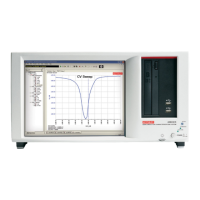4200-900-01 Rev. K / February 2017 Return to Section Topics 3-149
Model 4200-SCS User’s Manual Section 3: Common Device Characterization Tests
8. Before running the test for the first time, it is recommended to try out the project on a scrap
device:
a) Ensure that the project navigator is showing the FlashEndurance entry highlighted,
as shown in Figure 3-113.
b) Click the Run Test/Subsite button (in the red oval on Figure 3-113).
c) Ensure that the test cycles through each test in the project navigator, and that data
is input into the Subsite Data tab.
9. Move to a fresh device and click the Run Test/Subsite icon.
10. If errors or unexpected operation occurs, see the Error codes and Troubleshooting sections.
The following three projects are similar, and use the shared stress-measure
looping capability of the FlashEndurance projects:
• FlashDisturb-NAND project
• FlashDisturb-NOR project
• FlashDisturb-switch project
The purpose of the Disturb test is to pulse stress a device in an array test
structure, then perform a measurement, such as V
T
, on a device adjacent to the
pulsed device.
The goal is to measure the amount of V
T
shift in adjacent cells, either in the
programmed or erased states, when a nearby device is pulsed with either a
Program, Erase, or Program+Erase waveforms.
The typical measurement is a V
T
extraction based on a Vg-Id sweep, but any type
of DC test may be configured.
The difference between the FlashDisturb-NAND and FlashDisturb-NOR are the
typical pulse widths and levels specific to the DUT type. The FlashDisturb-switch
is a generic example of the Flash testing described above, but adds support for an
external Keithley switch matrix.
FlashDisturb tests
The FlashDisturb tests consists of the following tests:
• Program
• SetupDC-Program
•Vt-MaxGm-Program
•Erase
• SetupDC-Erase
•Vt-MaxGm-Erase
The six tests listed above are the same ones used for endurance testing (see
FlashEndurance-NAND tests for details).
Stressing for the disturb tests are configured from the subsite setup tab for a
disturb project subsite plan. The default subsite setup for FlashDisturb-NAND
(shown in Figure 3-122) uses Segment ARB
®
waveforms, defined and saved to
file using Kpulse, to perform log stressing that ranges from 100,000 to 1,000,000
counts.

